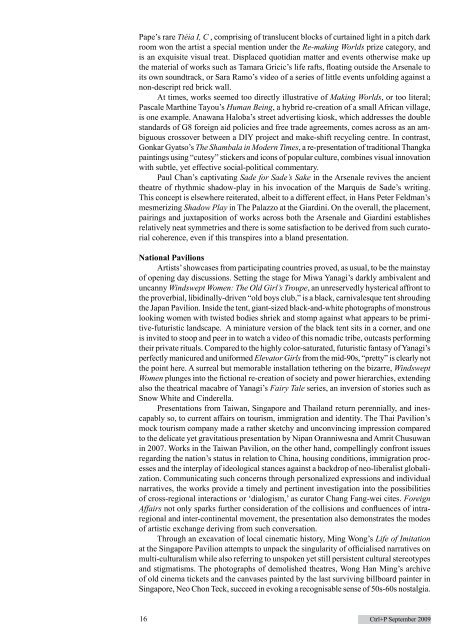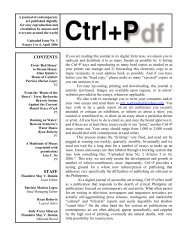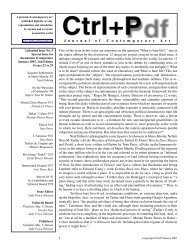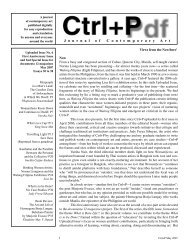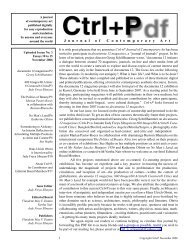Issue 15 - Pdf Ctrl+P - CTRL+P: a journal of contemporary art
Issue 15 - Pdf Ctrl+P - CTRL+P: a journal of contemporary art
Issue 15 - Pdf Ctrl+P - CTRL+P: a journal of contemporary art
Create successful ePaper yourself
Turn your PDF publications into a flip-book with our unique Google optimized e-Paper software.
Pape’s rare Ttéia I, C , comprising <strong>of</strong> translucent blocks <strong>of</strong> curtained light in a pitch dark<br />
room won the <strong>art</strong>ist a special mention under the Re-making Worlds prize category, and<br />
is an exquisite visual treat. Displaced quotidian matter and events otherwise make up<br />
the material <strong>of</strong> works such as Tamara Gricic’s life rafts, floating outside the Arsenale to<br />
its own soundtrack, or Sara Ramo’s video <strong>of</strong> a series <strong>of</strong> little events unfolding against a<br />
non-descript red brick wall.<br />
At times, works seemed too directly illustrative <strong>of</strong> Making Worlds, or too literal;<br />
Pascale M<strong>art</strong>hine Tayou’s Human Being, a hybrid re-creation <strong>of</strong> a small African village,<br />
is one example. Anawana Haloba’s street advertising kiosk, which addresses the double<br />
standards <strong>of</strong> G8 foreign aid policies and free trade agreements, comes across as an ambiguous<br />
crossover between a DIY project and make-shift recycling centre. In contrast,<br />
Gonkar Gyatso’s The Shambala in Modern Times, a re-presentation <strong>of</strong> traditional Thangka<br />
paintings using “cutesy” stickers and icons <strong>of</strong> popular culture, combines visual innovation<br />
with subtle, yet effective social-political commentary.<br />
Paul Chan’s captivating Sade for Sade’s Sake in the Arsenale revives the ancient<br />
theatre <strong>of</strong> rhythmic shadow-play in his invocation <strong>of</strong> the Marquis de Sade’s writing.<br />
This concept is elsewhere reiterated, albeit to a different effect, in Hans Peter Feldman’s<br />
mesmerizing Shadow Play in The Palazzo at the Giardini. On the overall, the placement,<br />
pairings and juxtaposition <strong>of</strong> works across both the Arsenale and Giardini establishes<br />
relatively neat symmetries and there is some satisfaction to be derived from such curatorial<br />
coherence, even if this transpires into a bland presentation.<br />
National Pavilions<br />
Artists’ showcases from p<strong>art</strong>icipating countries proved, as usual, to be the mainstay<br />
<strong>of</strong> opening day discussions. Setting the stage for Miwa Yanagi’s darkly ambivalent and<br />
uncanny Windswept Women: The Old Girl’s Troupe, an unreservedly hysterical affront to<br />
the proverbial, libidinally-driven “old boys club,” is a black, carnivalesque tent shrouding<br />
the Japan Pavilion. Inside the tent, giant-sized black-and-white photographs <strong>of</strong> monstrous<br />
looking women with twisted bodies shriek and stomp against what appears to be primitive-futuristic<br />
landscape. A miniature version <strong>of</strong> the black tent sits in a corner, and one<br />
is invited to stoop and peer in to watch a video <strong>of</strong> this nomadic tribe, outcasts performing<br />
their private rituals. Compared to the highly color-saturated, futuristic fantasy <strong>of</strong> Yanagi’s<br />
perfectly manicured and uniformed Elevator Girls from the mid-90s, “pretty” is clearly not<br />
the point here. A surreal but memorable installation tethering on the bizarre, Windswept<br />
Women plunges into the fictional re-creation <strong>of</strong> society and power hierarchies, extending<br />
also the theatrical macabre <strong>of</strong> Yanagi’s Fairy Tale series, an inversion <strong>of</strong> stories such as<br />
Snow White and Cinderella.<br />
Presentations from Taiwan, Singapore and Thailand return perennially, and inescapably<br />
so, to current affairs on tourism, immigration and identity. The Thai Pavilion’s<br />
mock tourism company made a rather sketchy and unconvincing impression compared<br />
to the delicate yet gravitatious presentation by Nipan Oranniwesna and Amrit Chusuwan<br />
in 2007. Works in the Taiwan Pavilion, on the other hand, compellingly confront issues<br />
regarding the nation’s status in relation to China, housing conditions, immigration processes<br />
and the interplay <strong>of</strong> ideological stances against a backdrop <strong>of</strong> neo-liberalist globalization.<br />
Communicating such concerns through personalized expressions and individual<br />
narratives, the works provide a timely and pertinent investigation into the possibilities<br />
<strong>of</strong> cross-regional interactions or ‘dialogism,’ as curator Chang Fang-wei cites. Foreign<br />
Affairs not only sparks further consideration <strong>of</strong> the collisions and confluences <strong>of</strong> intraregional<br />
and inter-continental movement, the presentation also demonstrates the modes<br />
<strong>of</strong> <strong>art</strong>istic exchange deriving from such conversation.<br />
Through an excavation <strong>of</strong> local cinematic history, Ming Wong’s Life <strong>of</strong> Imitation<br />
at the Singapore Pavilion attempts to unpack the singularity <strong>of</strong> <strong>of</strong>ficialised narratives on<br />
multi-culturalism while also referring to unspoken yet still persistent cultural stereotypes<br />
and stigmatisms. The photographs <strong>of</strong> demolished theatres, Wong Han Ming’s archive<br />
<strong>of</strong> old cinema tickets and the canvases painted by the last surviving billboard painter in<br />
Singapore, Neo Chon Teck, succeed in evoking a recognisable sense <strong>of</strong> 50s-60s nostalgia.<br />
16 <strong>Ctrl+P</strong> September 2009


